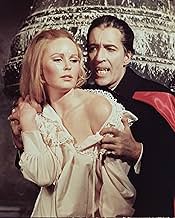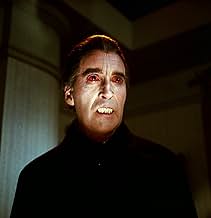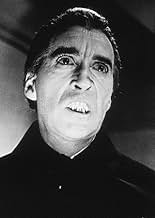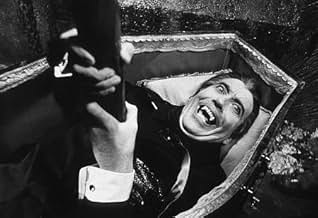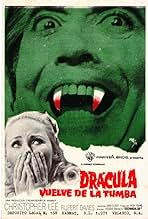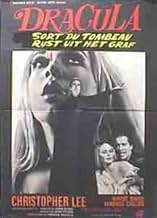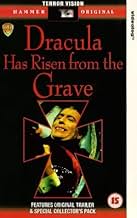CALIFICACIÓN DE IMDb
6.5/10
8.6 k
TU CALIFICACIÓN
Al exorcizar el castillo de Drácula, el Conde regresa de entre los muertos. Drácula sigue al Monseñor de vuelta a su localidad natal, donde su bella sobrina y sus amigas se convierten en pre... Leer todoAl exorcizar el castillo de Drácula, el Conde regresa de entre los muertos. Drácula sigue al Monseñor de vuelta a su localidad natal, donde su bella sobrina y sus amigas se convierten en presa.Al exorcizar el castillo de Drácula, el Conde regresa de entre los muertos. Drácula sigue al Monseñor de vuelta a su localidad natal, donde su bella sobrina y sus amigas se convierten en presa.
- Premios
- 1 nominación en total
Christopher Cunningham
- Farmer
- (as Chris Cunningham)
Carrie Baker
- First victim
- (sin créditos)
Donald Campbell
- Tavern Customer
- (sin créditos)
Frank Forsyth
- Villager
- (sin créditos)
Lindsay Hooper
- Tavern Customer
- (sin créditos)
Philip Stewart
- Tavern Customer
- (sin créditos)
John Timberlake
- Tavern Customer
- (sin créditos)
- Dirección
- Guionistas
- Todo el elenco y el equipo
- Producción, taquilla y más en IMDbPro
Opinión destacada
Released in the USA in the Winter of 1969, Hammer's "Dracula has Risen from the Grave" was the fourth entry in the series and the third with Christopher Lee in the title role. Here's a list of the nine films for those interested:
Horror of Dracula (1958); The Brides of Dracula (1960); Dracula: Prince of Darkness (1966); Dracula Has Risen from the Grave (1968); Taste the Blood of Dracula (1969); Scars of Dracula (1970); Dracula AD 1972 (1972); The Satanic Rites of Dracula (1973); and The Legend of the 7 Golden Vampires (1974).
"Dracula has Risen from the Grave" suffers from a weak prologue and first act. The prologue takes place a year prior to the main story. The first act involves two priests hiking up to Dracula's castle to exorcise it. One of the priests unwittingly resurrects the count and the vampire wants revenge on the other priest whom he discovers blessed his abode. The final hour involves Dracula going after his niece in a neighboring village. The niece's boyfriend and the priest must defend her.
Like I said, the whole first act isn't very promising, but things perk up with the introduction of the niece's boyfriend, Paul, and the pub his dad runs. Barbara Ewing plays Zena, the redhead waitress at the pub, and the film shows the close relationships between Paul, his father and Zena. The characters ring true and it draws the viewer into their world. Excellent job on this front.
A great scene takes place when Paul's girlfriend, Maria (played by the stunning Veronica Carlson), takes Paul to her home to introduce him to her mother and the priest, who's a Monsignor (whatever that is). Paul is cornered in a conversation and forced to reveal that he doesn't believe in God. The Monsignor is initially offended and rude, but this can be excused on the grounds that he's the father-figure to his beloved niece; besides there's a warmhearted scene later in the film where the Monsignor proves his loving nature.
Another unusual highlight of the film are the multiple scenes that take place on the labyrinthian rooftops of the Victorian village. I can't help but wonder how they accomplished this. Were they really filming on the rooftops of a village or is it an illusion accomplished through matte paintings or other effects? I'm sure it's the latter; regardless, it's excellent film work and a unique feature of this film.
Of course, Hammer films are renown for their curvaceous women and here we have two: Redhead Barbara Ewing as the very likable Zena, and Veronica Carlson, who can also be seen in the outstanding "Frankenstein Must Be Destroyed".
As with most of Hammer's horror flicks, the movie possesses a beautifully lush, Gothic atmosphere.
Despite the weak first act, the positives noted above compel me place "Dracula has Risen from the Grave" as my second or third favorite of the series. My favorite being "Taste the Blood of Dracula."
The film runs 92 minutes and was shot at Pinewood Studios, Buckinghamshire, England.
GRADE: B
Horror of Dracula (1958); The Brides of Dracula (1960); Dracula: Prince of Darkness (1966); Dracula Has Risen from the Grave (1968); Taste the Blood of Dracula (1969); Scars of Dracula (1970); Dracula AD 1972 (1972); The Satanic Rites of Dracula (1973); and The Legend of the 7 Golden Vampires (1974).
"Dracula has Risen from the Grave" suffers from a weak prologue and first act. The prologue takes place a year prior to the main story. The first act involves two priests hiking up to Dracula's castle to exorcise it. One of the priests unwittingly resurrects the count and the vampire wants revenge on the other priest whom he discovers blessed his abode. The final hour involves Dracula going after his niece in a neighboring village. The niece's boyfriend and the priest must defend her.
Like I said, the whole first act isn't very promising, but things perk up with the introduction of the niece's boyfriend, Paul, and the pub his dad runs. Barbara Ewing plays Zena, the redhead waitress at the pub, and the film shows the close relationships between Paul, his father and Zena. The characters ring true and it draws the viewer into their world. Excellent job on this front.
A great scene takes place when Paul's girlfriend, Maria (played by the stunning Veronica Carlson), takes Paul to her home to introduce him to her mother and the priest, who's a Monsignor (whatever that is). Paul is cornered in a conversation and forced to reveal that he doesn't believe in God. The Monsignor is initially offended and rude, but this can be excused on the grounds that he's the father-figure to his beloved niece; besides there's a warmhearted scene later in the film where the Monsignor proves his loving nature.
Another unusual highlight of the film are the multiple scenes that take place on the labyrinthian rooftops of the Victorian village. I can't help but wonder how they accomplished this. Were they really filming on the rooftops of a village or is it an illusion accomplished through matte paintings or other effects? I'm sure it's the latter; regardless, it's excellent film work and a unique feature of this film.
Of course, Hammer films are renown for their curvaceous women and here we have two: Redhead Barbara Ewing as the very likable Zena, and Veronica Carlson, who can also be seen in the outstanding "Frankenstein Must Be Destroyed".
As with most of Hammer's horror flicks, the movie possesses a beautifully lush, Gothic atmosphere.
Despite the weak first act, the positives noted above compel me place "Dracula has Risen from the Grave" as my second or third favorite of the series. My favorite being "Taste the Blood of Dracula."
The film runs 92 minutes and was shot at Pinewood Studios, Buckinghamshire, England.
GRADE: B
- Wuchakk
- 2 abr 2013
- Enlace permanente
Argumento
¿Sabías que…?
- TriviaThis was Hammer Films' most profitable movie.
- ErroresWhen the bell-ringer arrives at the church at the beginning of the movie he leaves his bicycle on the steps of the front door. When the priest arrives and rushes to investigate the screaming, the bicycle is no longer there.
- Versiones alternativasThe UK cinema version was cut by the BBFC to remove some closeup shots of Dracula pulling a stake from his heart. Later video and DVD releases were uncut.
- ConexionesFeatured in Prueba la sangre de Drácula (1970)
Selecciones populares
Inicia sesión para calificar y agrega a la lista de videos para obtener recomendaciones personalizadas
Detalles
- Fecha de lanzamiento
- País de origen
- Idiomas
- También se conoce como
- Dracula Has Risen from the Grave
- Locaciones de filmación
- Productora
- Ver más créditos de la compañía en IMDbPro
- Tiempo de ejecución1 hora 32 minutos
- Mezcla de sonido
- Relación de aspecto
- 1.66 : 1(original/negative ratio)
Contribuir a esta página
Sugiere una edición o agrega el contenido que falta

Principales brechas de datos
What is the French language plot outline for Drácula vuelve de la tumba (1968)?
Responda










